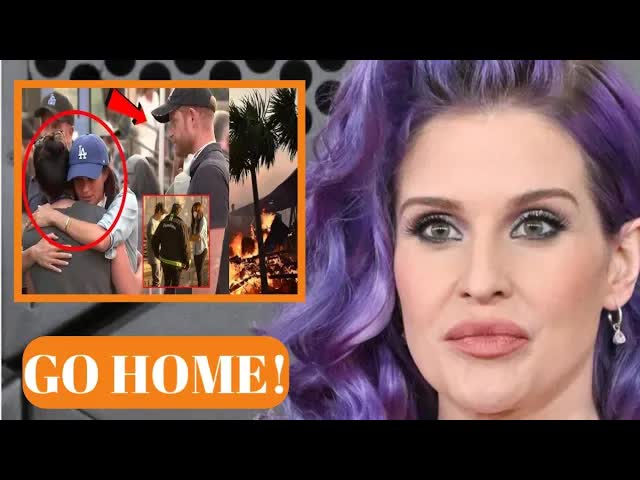In a fiery backlash that has ignited conversations across social media, Kelly Osbourne has taken Harry and Meghan to task over their recent visits to sites affected by the devastating California wildfires.
Her critique paints the couple’s actions as what she terms “disaster tourism,” suggesting they are more interested in garnering publicity than providing genuine aid.
As smoke continues to swirl through the charred remains of communities, the presence of the Duke and Duchess of Sussex at these locations has sparked heated discussions about the delicate balance between altruism and self-promotion.
Osbourne, known for her candid opinions, has become an unexpected spokesperson for public discontent.
During a recent podcast appearance, she didn’t hold back, stating, “No one needs your orchestrated hugs while their homes are literally turning to ash.” Her words resonate with the pain felt by those who have lost everything, as she critiques the couple’s approach to disaster relief.
The sight of Harry and Meghan accompanied by a camera crew has raised eyebrows, leading many to question the sincerity of their outreach efforts.
The Sussexes were seen interacting with emergency responders and local residents, but critics argue that the presence of professional photographers capturing every moment raises doubts about the authenticity of their compassion.
A particularly controversial moment featured Meghan embracing a fire victim, which some hailed as a heartfelt gesture, while others pointed out the perfectly staged nature of the shot, reminiscent of their previous post-royal endeavors.
“There’s a special kind of tone deafness in turning up to a disaster zone with a professional photography team,” Osbourne remarked, echoing the sentiments of many Californians.
She emphasized that these visits should not be treated like red carpet events, but rather as solemn occasions reflecting real human tragedies.
The timing of their appearances has also drawn skepticism, especially in light of Netflix’s reported dissatisfaction with their content, leading some to speculate that these visits serve as a convenient source of dramatic footage for future projects.
Local emergency services personnel have expressed mixed feelings regarding the high-profile visits.
While some acknowledge that any attention could be beneficial, others have voiced concerns that managing crowd control for the couple’s appearances diverted critical resources from ongoing emergency response efforts.
One firefighter shared, “We had to redirect three units to manage crowd control when they showed up.
That’s not what we need during an active emergency.”
The criticism has been particularly directed at Meghan, whose polished image during these visits has provoked unfavorable comparisons to other public figures engaged in genuine humanitarian work.
Osbourne pointed out the stark contrast, recalling how Sandra Bullock quietly donated millions to disaster relief without making it a spectacle.
“You don’t need a press release and a photo gallery to make a difference,” she asserted.
As the fires rage on, the controversy surrounding Harry and Meghan’s approach to public service has reignited broader discussions.
Since stepping back from royal duties, critics argue that the couple has sought to monetize their humanitarian efforts, transforming altruism into content for their media projects.
Royal commentators have noted a significant difference between their strategy and that of other royals, such as Princess Anne, who has dedicated decades to charitable work without seeking the limelight.
On social media, the backlash has been palpable, with users creating viral memes that juxtapose the couple’s carefully curated appearances against the backdrop of devastation.
The hashtag #tragedytourists gained traction following Osbourne’s remarks, reflecting a growing sentiment among the public.
Supporters of the Sussexes argue that their presence helps keep media attention on the disaster, potentially increasing aid to affected areas, yet this defense is undermined by reports indicating that local charities received no direct support during their visits.
“If you want to help, write a check,” Osbourne suggested, emphasizing that victims need tangible assistance rather than performative gestures.
The situation underscores a shift in how celebrities engage with natural disasters.
In the past, stars often contributed quietly, but today’s social media landscape pressures public figures to showcase their charitable efforts, sometimes blurring the lines between genuine compassion and self-serving publicity.
As California grapples with the aftermath of the wildfires, the debate surrounding celebrity involvement in disaster response rages on.
Despite the outcry, representatives for Harry and Meghan have remained largely silent on Osbourne’s criticisms, maintaining that their intentions were purely humanitarian.
In a time when communities are reeling from loss, the spotlight on celebrity actions reveals a complex interplay of empathy, optics, and public perception.
The emergence of celebrities, including Meghan Markle, in the wake of tragedy has sparked a curious phenomenon: a parade of well-known faces eager to lend their support, often accompanied by cameras.
However, with this attention comes scrutiny.
As public outrage grows, calls for authentic engagement overshadow the couple’s attempts to show solidarity with those affected by the wildfires.
The question remains: can true compassion coexist with the need for visibility in a world obsessed with social media?
